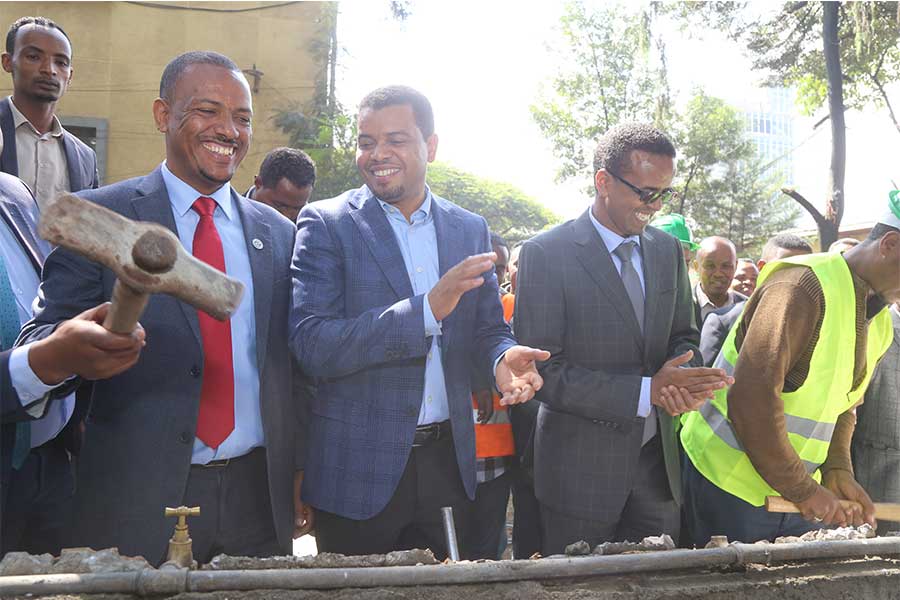
Fortune News | Apr 22,2023
Jan 18 , 2020
By Shewangezaw Seyoum
The new bill that plans to centralise public project management will not be able to address the challenge that is faced. It is instead beneficial to take stock of emerging trends in choosing the best for the construction of public projects, writes Shewangezaw Seyoum (swsm02@yahoo.com), a consultant who works at the Industrial Projects Service - a consultancy house under the Industrial Parks Development Corporation. Views expressed here do not represent that of any organisation.
Parliament will soon discuss yet another vastly important bill. This one concerns the governance and management of public projects. This piece of legislation comes not long after spectacular public project failures that are still fresh in the minds of citizens.
The bill could have repercussions far and wide considering the huge amount of money involved in these public projects and the large number of stakeholders that will potentially be affected by it.
Many of the mega projects that have failed, been delayed or had cost overruns were the results of the Growth & Transformation Plans (GTPs), which were introduced as a transformative initiative. Notwithstanding the intention, the implementation of large infrastructure and economic development projects proceeded without adequate forethought and oversight.
Perhaps the case of ten sugar development projects highlights the issue better than anything else. As a result, most of the projects went over the planned deadline and starting budget. Some were not even started. The billions of dollars in value that were promised to be created never materialised. And yet millions of dollars went down the drain, most of it barely accounted for even to this day.
The damage caused by public project failures was not limited to the projects themselves. Loans tied to government projects had increased non-concessional government guaranteed borrowing. Delays in completing key export-oriented projects also meant maturing loans could not be met from proceeds that were expected from these projects.
The resulting debt accumulation exacerbated macroeconomic imbalances and threatened access to foreign financing, investor confidence and economic growth.
The causes for this were the absence of accountability, project prioritisation, strict management guidelines and a proper legal framework.
It is against this backdrop and with a view of filling the perceived gaps that the Planning & Development Commission prepared a bill providing for the governance and management of public projects. Nonetheless, it did not take enough note of the requisite capacity and mindset for effective and seamless governance of public projects. It also underestimates the immense complexity of public projects and the next phase of public investment management modalities.
The bill prescribes processes to be followed and assigns responsibilities for governance and management of public projects. In the case of pre-implementation, the bill proposes mandatory feasibility study preparation and a set of processes to be completed right from idea generation and identification and prioritisation up to approval. For major projects, it entrusts the Commission to undertake an appraisal.
Impulsive public officials might indeed initiate projects based on feelings and judgments and the imposition of systematic and dispassionate analysis could be helpful in that sense.
But when a particular institution is put in charge and acts as a clearing house, it creates its own problem and might do a disservice to the projects. Given the capacity and morale of the human resources of public institutions, it will result in lengthy processes and delays. It might outsource some of the workloads as it is suggested, for which it would have to pay, but this would not make it any faster.
The experience of public consultancy houses attests to this argument. Consultancy houses do not permanently employ experts in every conceivable area. They have to use the service of specialists employed temporarily. Excessive time is taken to complete studies and delays are very much common in these institutions.
The implementation and subsequent management is also to be handled in a similar fashion. In this case, primarily Ministry of Finance is to work in conjunction with other ministries and agencies such as the Ministry of Urban Development & Construction, the Public Procurement & Administration Agency and the Federal Integrated Infrastructure Development Coordination Agency. This will not expedite projects either.
Public institutions have repeatedly shown they are not good at working in coordination. Just look at road construction across Addis Abeba. Not long after a road is finished, it cab be dismantled once again for the sake of some other infrastructure. Neither is the coordination between the Procurement Service, the Ethiopian Standard Agency and the Ethiopian Conformity Assessment Agency something that should give us confidence.
Worse, as we move to the next phase of public investment, we will have to consider emerging trends in choosing the best contractual strategy for the construction of major projects. This may be in power, irrigation, transport or industrial development. Innovations in project organisation, management and procurement have already provided alternative approaches.
Perhaps the most famous of these approaches is what is known as the design-and-build procurement model, which to an extent exists in Ethiopia but not on the level that it should.
In this model where, a contracting organisation takes sole responsibility, normally on a lump-sum fixed-price basis, for both the design and construction of a project. This would have implications for the design of governance and administration of public projects.
Projects are the basic building blocks of development. Without successful project identification, preparation and implementation, development plans are no more than wishes. As the number of public projects increases and become more complex, substantial changes in project governance and management systems needs to be made. But traditional approaches based on legalistic, centralised and regulatory procedures are not adequate to deal with the dynamics of change.
Project success is about the realisation of outcomes and ultimately the level of achievement in delivering positive change. For this to happen, we need to appreciate the magnitude of the challenge of not only now but also ahead and come up with innovative approaches.
PUBLISHED ON
Jan 18,2020 [ VOL
20 , NO
1029]


Radar | Oct 15,2022

Radar | Jan 27,2024

Fortune News | Jun 04,2022

Viewpoints | Oct 12,2024

Agenda | Jul 13,2019

My Opinion | 131770 Views | Aug 14,2021

My Opinion | 128153 Views | Aug 21,2021

My Opinion | 126099 Views | Sep 10,2021

My Opinion | 123721 Views | Aug 07,2021

Dec 22 , 2024 . By TIZITA SHEWAFERAW
Charged with transforming colossal state-owned enterprises into modern and competitiv...

Aug 18 , 2024 . By AKSAH ITALO
Although predictable Yonas Zerihun's job in the ride-hailing service is not immune to...

Jul 28 , 2024 . By TIZITA SHEWAFERAW
Unhabitual, perhaps too many, Samuel Gebreyohannes, 38, used to occasionally enjoy a couple of beers at breakfast. However, he recently swit...

Jul 13 , 2024 . By AKSAH ITALO
Investors who rely on tractors, trucks, and field vehicles for commuting, transporting commodities, and f...

Jul 5 , 2025
Six years ago, Ethiopia was the darling of international liberal commentators. A year...

Jun 28 , 2025
Meseret Damtie, the assertive auditor general, has never been shy about naming names...

Jun 21 , 2025
A well-worn adage says, “Budget is not destiny, but it is direction.” Examining t...

Jun 14 , 2025
Yet again, the Horn of Africa is bracing for trouble. A region already frayed by wars...

Jul 6 , 2025 . By BEZAWIT HULUAGER
The federal legislature gave Prime Minister Abiy Ahmed (PhD) what he wanted: a 1.9 tr...

Jul 6 , 2025 . By YITBAREK GETACHEW
In a city rising skyward at breakneck speed, a reckoning has arrived. Authorities in...

Jul 6 , 2025 . By NAHOM AYELE
A landmark directive from the Ministry of Finance signals a paradigm shift in the cou...

Jul 6 , 2025 . By NAHOM AYELE
Awash Bank has announced plans to establish a dedicated investment banking subsidiary...